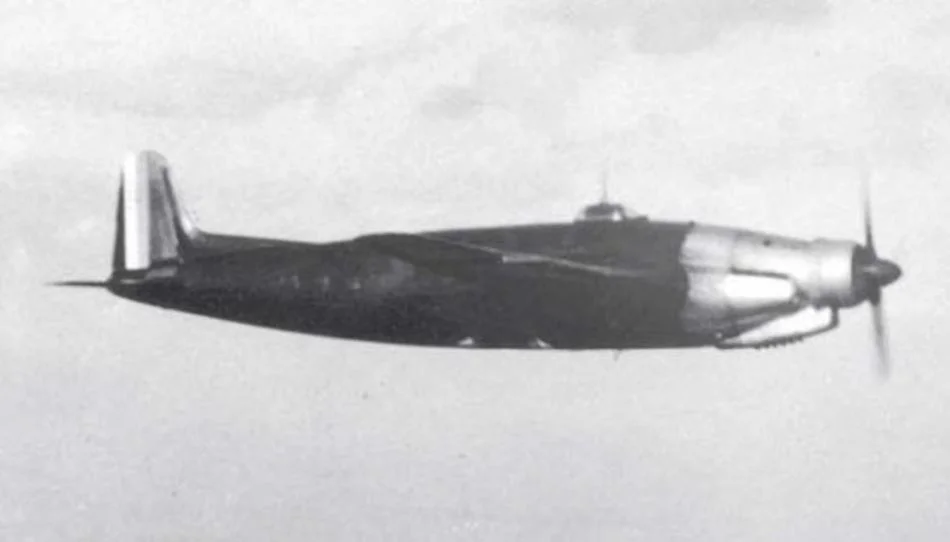The NC.3021 Belphégor was a French single-propeller high-altitude research aircraft that was powered by two Bf 109 engines stuck together, turning a large 4.5 meter-wide prop. While it only had a “single” engine, the NC.3021 was absolutely massive.

The aircraft began development before the Second World War began, and ran almost until the 1950s. It was a high-altitude research platform meant to help France catch up after their technological hiatus during the war, but it was not a good design.
With blended wings, a German engine, great size, and a pressurised crew compartment, this is a fascinatingly weird machine.
 Note the person on the far left of the image for scale.
Note the person on the far left of the image for scale.
Background
When France was liberated from Nazi occupation in 1944, they had much catching up to do. Progress in most sectors, including naval, aviation and civil industries had been paused or slowed after the occupation, so France was massively behind Allies like the US and UK.
They had been a world leader in many areas before the war, but now these projects were years out of date. To catch up, France had to restart relevant projects as a basepoint.
One important area France needed to overcome was aircraft pressurisation. With aircraft travelling higher and faster than ever before, pressurisation was becoming a requirement for modern designs.
 The Farman F.1000 high-altitude research aircraft.
The Farman F.1000 high-altitude research aircraft.
Before the war the company Avions Farman (Farman) had been working on a pressurised, high-altitude research aircraft, the F.1000.
The aircraft showed promise, able to reach 34,000 ft (10,000 meters), but its pressure system failed and the aircraft was lost before its design could be proven.
In the late 1930s Ferman was merged with other companies into the nationalised design office SNCAC (Société Nationale de Constructions Aéronautiques du Centre).
The constituents of Farman continued its work on high-altitude aircraft within SNCAC.
 An early model of the SO.3020.
An early model of the SO.3020.
Progress was made on the SO.3020, which was intended to be used to study the earth’s atmosphere. The SO.3020 was planned to have two Hispano-Suiza 12Z V12 engines powering a contra-rotating propeller.
It was to be pressurised, and capable of reaching over 40,000 ft. However the Second World War heavily disrupted the aircraft’s development, which only properly resumed in 1944. By 1946 the SO.3020 was mostly complete, but it lacked an engine.
By this point the war was over, and France had access to plenty of German technologies. With the Hispano-Suiza engine unavailable, SNCAC instead opted to power the SO.3020 with a monstrous German engine: the DB 610.
 The 24 cylinder, twin-supercharged DB 610 double-V12 engine.
The 24 cylinder, twin-supercharged DB 610 double-V12 engine.
The DB 610 was comprised of two DB 605 engines connected together in an inverted “vee” arrangement to share a common output. With 24 cylinders and a total displacement of 71.4 litres (5,438 cu in), the DB 610 produced 3,000 hp.
The engine was very powerful, but it suffered from reliability issues that would soon crop up for this aircraft.
The DB 610-powered SO.3020 was renamed the NC.3021. The aircraft had also received the name Belphégor, the name of a mythical demon that seduces victims with great inventions and new discoveries.
It is an odd name to choose for an aircraft, but one that would prove surprisingly apt for the NC.3021.
 The weird-looking NC.3021.
The weird-looking NC.3021.
Officially the NC.3021 was a flying laboratory developed for research purposes only. It would increase France’s understanding of pressurised aircraft, and allow them to research the stratosphere and cosmic rays. However, it may have had a secret purpose.
The NC.3021 Belphégor’s Design
Despite only having a single propeller, the NC.3021 was an enormous aircraft. In physical size, it was only slightly smaller than the B-17 Flying Fortress, measuring 57 ft (17.5 meters) in length and having a wing span of 73 ft (22.3 meters). Empty, it weighed 16,500 lbs (7,500 kg) while fully loaded it weighed 22,000 lbs (10,000 kg).
It was also a very tall aircraft, reaching (19 ft) 5.82 meters at its highest point. It was so large that you could walk right under its wings.
 The NC.3021’s rear section was constructed from wood.
The NC.3021’s rear section was constructed from wood.
The wings were mid-mounted and blended into the fuselage. We have been unable to establish why the wings were so heavily blended into the fuselage, although it may have been a left-over from the SO.3020, which may have housed its engines in the wing roots.
The wings were constructed from a combination of wood and metal. The aircraft’s tail was also constructed of wood.
The DB 610 engine was located at the front of the fuselage. Its cowling, 14 ft 9 in (4.5 meter) wide propeller, and nose cone appear to have been taken from the German He 177, which also used the DB 610 engine.
 Note the wings blended into the fuselage at the roots.
Note the wings blended into the fuselage at the roots.
The NC.3021 was a tail dragger, with two retractable landing gear struts under the wings, and one retractable tail wheel.
Its fuselage was wide, long and tapered at both ends. It was disproportionately large for a typical single propeller aircraft, being wider than that of a B-17.
In the center of the fuselage was a large pressure chamber that contained the aircraft’s crew of five.
These were a single pilot, a navigator, a radio operator, and two engineers to operate the scientific apparatus on board.
 NC.3021 cockpit.
NC.3021 cockpit.
The cylindrical pressure chamber was double-walled and 2.5 meters across at its widest. Offering a volume of 390 cu ft (11 m3), the chamber was big enough to walk around in and provided the necessary room for the engineers to perform their measurements.
On the very top of the cylinder was a small canopy and the pilot’s cockpit, which was also pressurised. At the bottom of the cylinder was a clear viewing window.
The chamber allowed the crew to function normally at high altitudes without the use of bulky heated suits or individual oxygen supplies.
 Note the observation window on the belly of the aircraft. Also note the small canopy on top of the aircraft.
Note the observation window on the belly of the aircraft. Also note the small canopy on top of the aircraft.
Air pressure was maintained by an intake, visible underneath the engine. Air would enter here and be compressed by engine-driven compressors, before passing over the engine’s exhaust manifolds to warm up before entering the cabin.
As an experimental aircraft intended for scientific studies, the NC.3021 Belphégor lacked any armament or even the provisions for carrying ordnance.
Its flight performance is difficult to gauge, as it seems that the aircraft’s limits were never found due to a lack of testing. However it had an estimated top speed of 350 mph and a maximum altitude of 42,000 ft (13,000 meters).
 The NC.3021’s strange side-profile while in flight.
The NC.3021’s strange side-profile while in flight.
Why it was a Disappointment
On June 6, 1946 the NC.3021 Belphégor took off for the first time, from Toussus-le-Noble Airport in France. Almost immediately though, the aircraft ran into problems.
The DB 610 powerplant suffered from severe cooling problems that significantly impacted their NC.3021’s reliability. Not only did it break often, but it was complicated to repair.
This made testing difficult, and it only racked up 40 hours of flight time over over its first three years of testing.
During one test flight in 1946 one of the main landing gear collapsed. This was repaired, and the aircraft remained in testing for the next few years.
 Despite years of the development, the NC.3021 spent little time actually in the air.
Despite years of the development, the NC.3021 spent little time actually in the air.
Thousands of hours went into refining the NC.3021, including adding an extension onto the vertical stabiliser to improve stability. But few flights were made in comparison to the efforts going into it, and it was never able to properly find its maximum altitude.
No scientific experiments or measurements were ever conducted on the aircraft.
The French government pulled funding for the NC.3021 Belphégor in 1949, and soon after its manufacturer, SNCAC, folded. The sole example was probably scrapped.
So, with years of development and only a handful of flights that never truly established what it could do, the NC.3021 was a disappointment.
 The Belphégor failed to achieve its design goals. Could its issues have been remedied for more time and resources? Most likely.
The Belphégor failed to achieve its design goals. Could its issues have been remedied for more time and resources? Most likely.
This aircraft was, at its basis, a pre-war design, still being tested and developed in the late 1940s and almost 1950s.
By this time, the US, had detonated the atomic bomb four years earlier, and, with the B-29 Superfortress, had developed, introduced, mass-produced, and began phasing out a much larger, fully pressurised bomber.
During the NC.3021’s development, the jet engine had become standard, and guided air-to-air missiles had been tested.
In short, the NC.3021 was simply out of date. It was a large drain on resources at a time when France needed to catch up, and it was never able to contribute as a research platform.
 The NC.3021 Belphégor was huge.
The NC.3021 Belphégor was huge.
A Secondary Purpose
The NC.3021 Belphégor, as obscure as it is, is only known as an aircraft for scientific research. But there is some suspicion that the aircraft may have had a secondary function in mind: high-altitude reconnaissance.
This theory stems from the aircraft’s particular, yet specific design features, most notably, the clear window in the belly of the fuselage that may have served as a viewport for a camera.
Was the NC.3021 Belphégor a spy plane? Maybe. For now, it is unclear.





